Ministry Leaders Less Optimistic About Revenue Projections
Results from July 2024 quarterly survey of ministry leaders—greatest challenges, NDA use, and aging/tenure trends
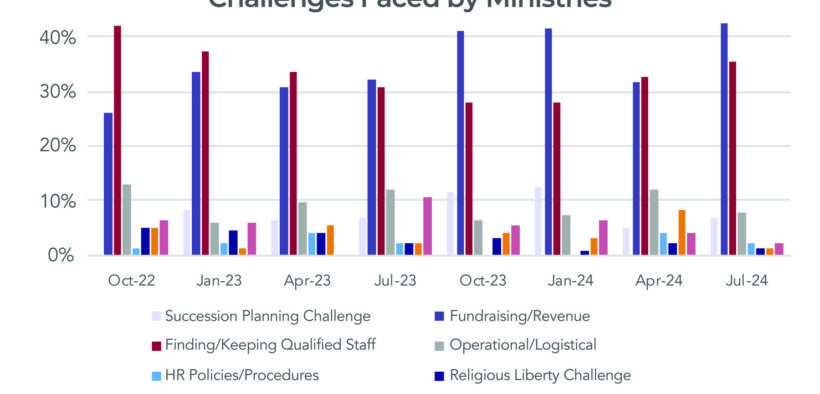
As part of its work serving donors and ministries, MinistryWatch conducts a quarterly survey of leaders of the largest 1,000 Christian ministries in the country. We began the survey in October 2022, and thanks to your help, we have gathered eight surveys of results and reported about the insights they have provided.
In July, we received responses from 89 ministry executives, 92% of whom are in the top role at the organization — CEO, president, or executive director. Responses to our survey have been growing; however, summertime surveys bring challenges as many top executives take sabbaticals or vacations during the slower summer season. We remain grateful to all of the leaders who have participated.
While we recognize the response size is somewhat limiting, we believe the trends we have seen are still noteworthy.
Most Significant Challenge for Ministry Leaders
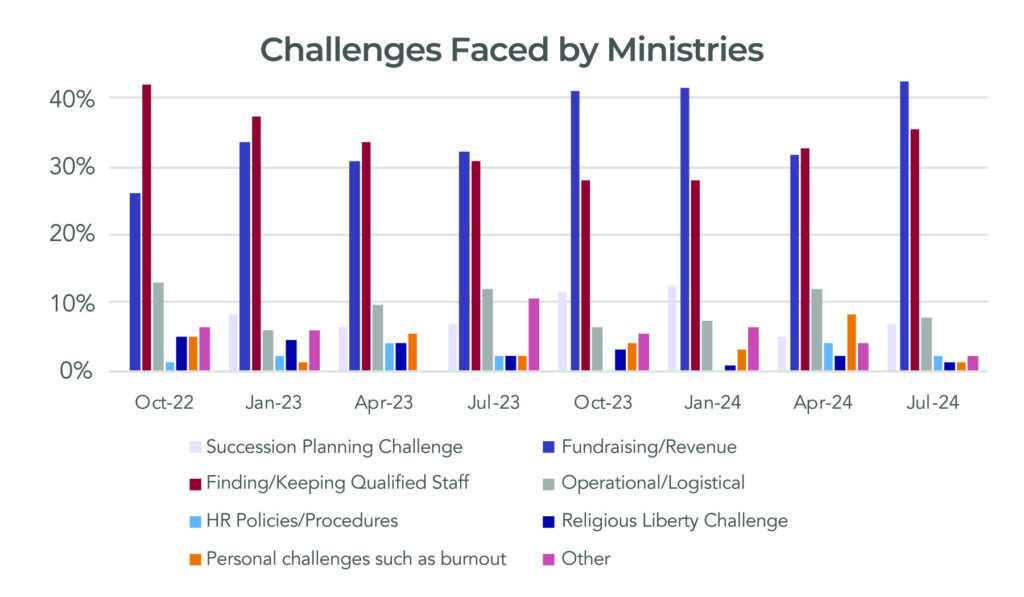
According to ministry leaders, the most significant challenge they face vacillates between fundraising and staffing.
As seen in the chart — represented by the red bar — early in the survey, finding and keeping staff was the top challenge leaders faced as the country emerged from the pandemic.
While that continues to be a top choice, fundraising/revenue remain the biggest challenge in most surveys since last year.
In this quarter’s survey, fundraising again took the top spot as the most significant challenge by seven points — 43% of leaders cited fundraising and 36% cited staffing.
Rick Dunham, past chair of Giving USA, told MinistryWatch he is not surprised fundraising continues to be a challenge. According to the most recent Giving USA report, “Giving to religion grew the slowest of any subsector except for international affairs.”
Other stressors include operational and logistical challenges, human resource policies, religious liberty challenges, personal challenges like burnout, and succession planning.
Respondents are also given space to provide their own response. One cited a capital campaign, another pointed to the challenge of finding and equipping volunteers.
Notably, one leader wrote that his or her biggest challenge is, “Preparing ministry for my retirement” along with “aging of major donors.” Aging is an issue we also address in this survey.
Ministry Revenue
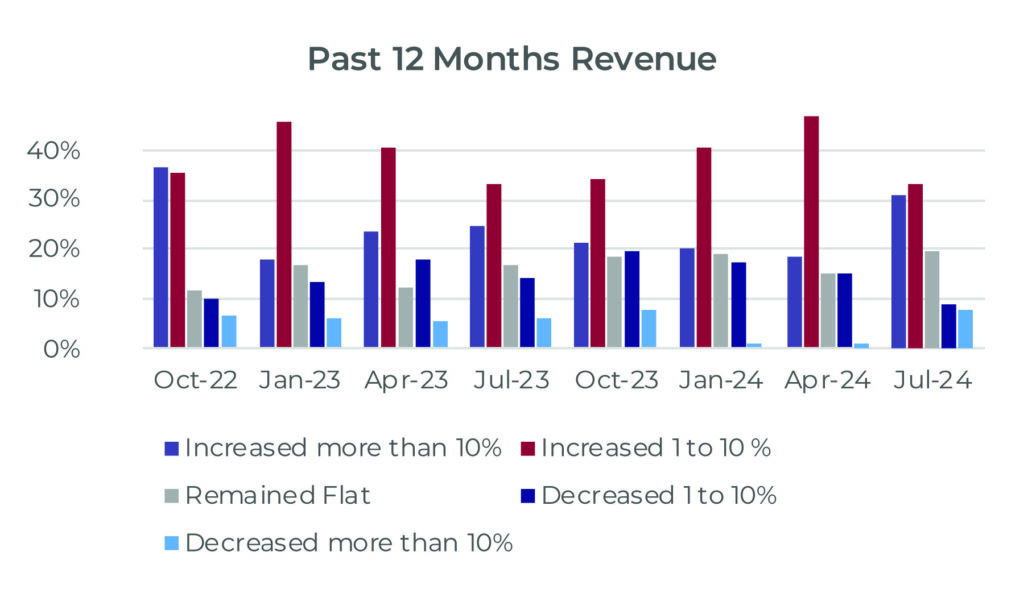
Given that 43% of respondents cited fundraising and revenue as their top concern, one might expect they’ve been facing fundraising challenges.
And yet, over 30% of the ministry leaders answered that their ministry has experienced revenue growth of over 10% in the last 12 months. Only 18% said they’d seen that sizable growth in the April survey.
As the chart demonstrates, most ministries during the course of our surveys since October 2022 have said they’ve seen growth. Over 63% of survey respondents saw revenue growth of at least 1% in the last 12 months.
The percentage of respondents who say their ministry revenue remained flat — represented by the gray bar — has been trending upward a bit, with 19% of respondents choosing that answer in the July 2024 survey, up from 15% in April. And almost 8% saw a decrease in revenue of more than 10% in the last year.
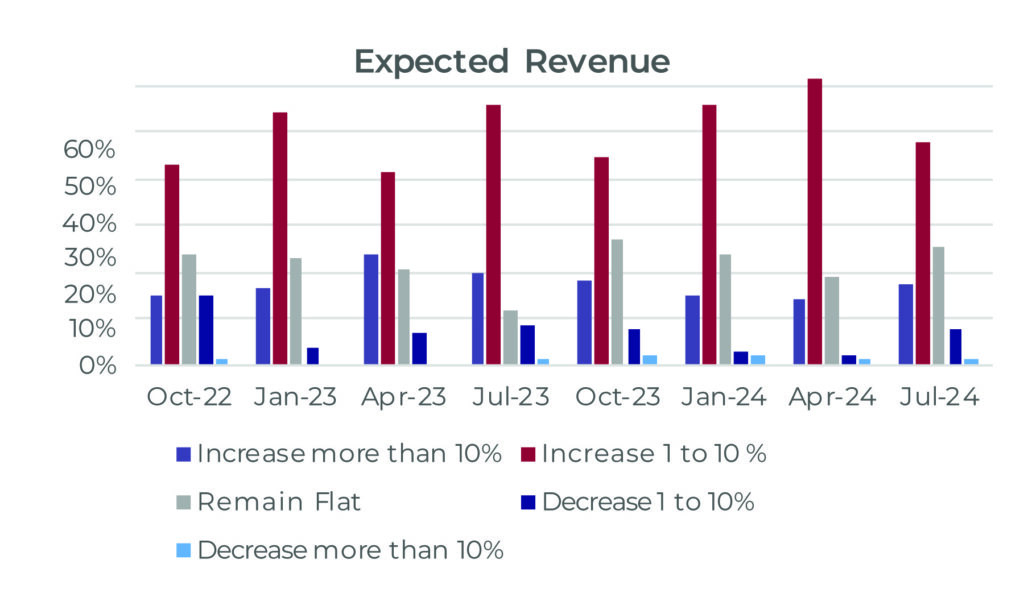
Ministry leaders continue to be optimistic about their revenue over the next 12 months, but not quite as optimistic as the surveys from January and April.
In July, almost 65% of leaders said they believe their revenue will increase in the next 12 months. That is down from almost 76% in April and 71% in January.
When it comes to projecting revenue over the next 12 months, 25% of leaders believe it will remain flat. That is very similar to the range of responses received over the course of the survey.
Nine percent of respondents expect their revenue to decrease, the highest percentage of leaders we’ve seen expecting a decrease since October 2023.
About the revenue responses Dunham said, “According to Giving USA, we are coming off of a decline in charitable giving in 2022 and giving being fairly flat in 2023. Wage growth did not keep pace with inflation in 2022 into 2023, but wage growth has rebounded and inflation has subsided. So I’m not surprised that giving is up, but that it still feels challenging in light of the economy and persistent inflation.
Nondisclosure Agreements (NDAs)
There has been a debate in recent years over how and why Christian ministries use NDAs as part of their operations. Sometimes NDAs are used to protect confidential information about how a ministry operates. At other times, they prevent persons from discussing the terms of a settlement agreement. NDAs are binding, and violations can result in a lawsuit.
We began asking about the use of NDAs in April 2023. In that survey, 47% of ministries answered that they use NDAs, 49% said they didn’t use them, and 4% said they didn’t know.
In the most recent survey, 39% of respondents said they use NDAs, 54% said they don’t use them, and 7% said they didn’t know.
We then asked leaders to elaborate about the purposes for using NDAs. Over 70% responded that they are used for protection of proprietary information, 41% said they are used as part of standard onboarding agreement/employee handbook (up from 24% in April 2023), and 41% use them as part of severance or settlement agreements (up from 27% when we first asked the question).
How many years have you been in this position?
Of ministry leaders who responded, 46% have been leading their organization for 10 years or more. When expanded to a broader range to include those who’ve led for at least seven years, it rises to over 60%. Turnover at the top appears to be uncommon.
However, new leaders are slowly moving in. Nearly 23% of leaders in this quarter’s survey have been in their positions for three years or less.
What age are Christian ministry leaders?
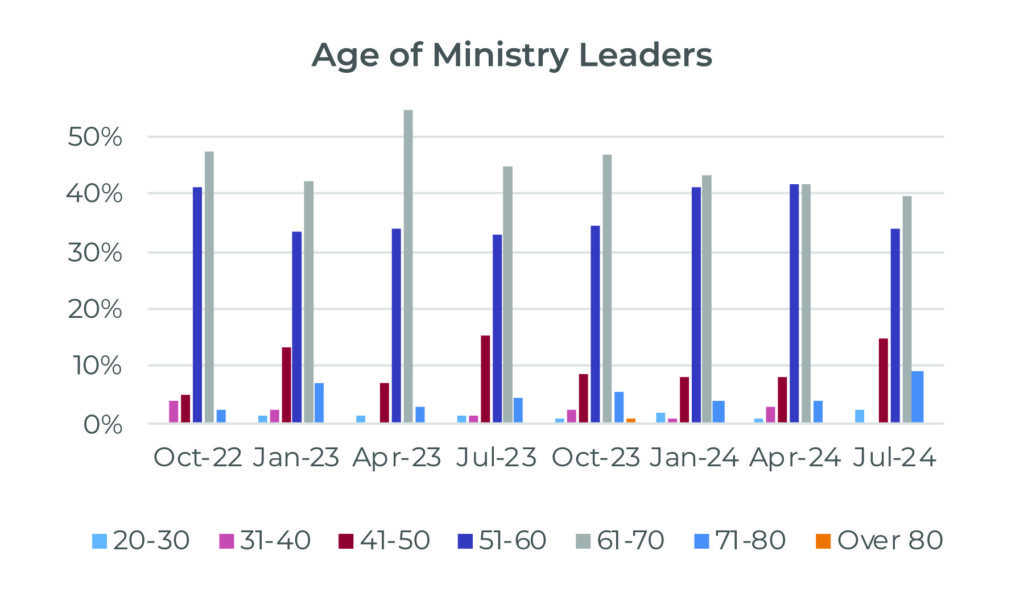
The long-serving tenure of Christian ministry leaders in their positions also illustrates that many are getting older.
The number of respondents between age 61 and 70 has remained high in each of our surveys — represented by the chart’s gray bar. It peaked in April 2023 with over 50% of respondents fitting the 60s age category. This quarter, we had the largest number of respondents in their 70s, at 9%.
As we reported from the January survey, we appear to be seeing a trend toward turnover and younger leadership. Again this quarter, over 50% of the respondents are under age 60.
Are you male or female?
The vast majority of the leaders who respond to our survey are male. Just under 20% of the respondents are women.
As we’ve reported in the past, more women are at the helm of Christian ministries than those leading secular businesses. According to the the Pew Research Center, “the share of women CEOs of Fortune 500 companies reached an all-time high of 10.6% in 2023, with 53 women heading major firms.”
TO OUR READERS: Do you have a story idea, or do you want to give us feedback about this or any other story? Please email us: [email protected]
Access to MinistryWatch content is free. However, we hope you will support our work with your prayers and financial gifts. To make a donation, click here.








